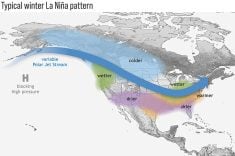Precision farming just got more precise.
The United States military has stopped scrambling the satellite signals used by global positioning systems.
That means basic GPS machines that usually have a margin of error of 30 to 40 metres can now pinpoint a spot within a five to 10 m radius, said precision farming expert Greg Reinhardt.
“Some guys who show an initial interest in precision farming want to get their feet wet, they want to experiment with it a little bit, but they don’t want to spend a whole lot of money to get started.”
Read Also

Canadian Food Inspection Agency extends chronic wasting disease control program consultation deadline
Date extended for consultation period of changes to CWD program
Those people tend to buy inexpensive hand-held machines.
“I think in many cases they were disappointed with the accuracy they got out of (those machines) because it was in that 40 m range.”
Reinhardt said GPS equipment has become more useful now that they it receives unscrambled signals.
For instance, a farmer who comes across a big rock during seeding can mark the spot using his GPS and be assured that he can find the rock later and remove it before harvest.
Farmers can use the hand-held machines when taking benchmark soil samples, using the GPS to return to the same vicinity year after year.
Farmers will also be able to use the $300 to $400 GPS machines to conduct crop scouting. For example, it can help locate an area of crop stress identified through an infrared aerial photograph.
“That area is probably going to be something in the order of half an acre to an acre to be of any particular interest and five to 10 m of accuracy is going to be good enough to navigate to that location.”
But farmers interested in using GPS technology to guide their combines and sprayers, or to log data on how much chemical has been applied or what kind of yields they are getting, will still need to buy machines capable of receiving differentially corrected signals.
These DGPS machines used to correct for errors caused by U.S. military scrambling, but they also correct for errors generated by the signal passing through the ionosphere.
Don Saelhof, marketing manager for Millstreet Ag Depot, one of the leading retailers of GPS equipment in Canada, said these more expensive DGPS machines are accurate to within half a metre now that the signals are no longer scrambled.
“Farmers are still going to have to have a differentially corrected signal to be able to practice precision farming,” said Saelhof.
Reinhardt said there have been a few other GPS developments:
- There was some talk about the U.S. aviation industry launching its own correction system that farmers could receive with regular GPS technology at no extra cost, but that initiative has been put off for a couple of years.
- John Deere recently introduced its StarFire DGPS system that is capable of achieving 10-inch average accuracy. There are other machines that can deliver that kind of accuracy, but they cost about four times as much as the StarFire receiver, Reinhardt said.















